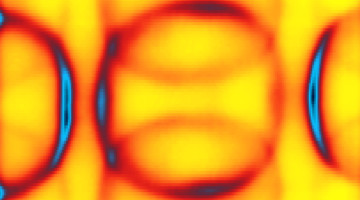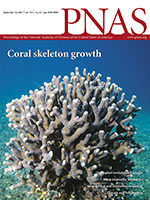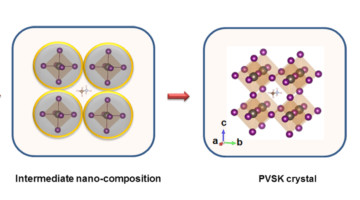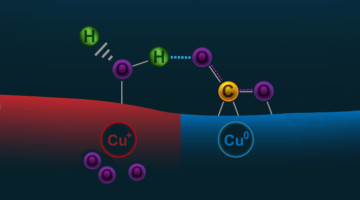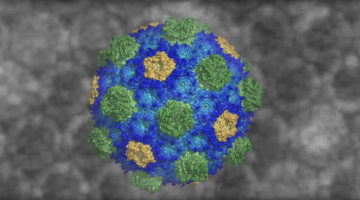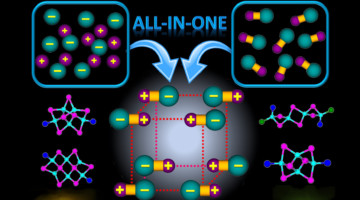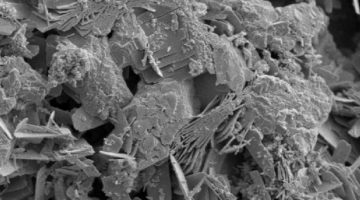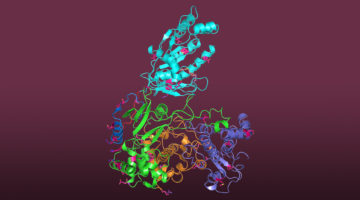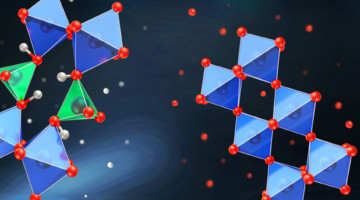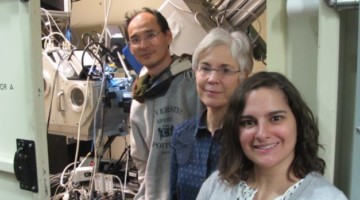Copper oxides are important for superconductivity applications but are difficult to understand due to complex charge, spin, and orbital interactions. Now, studies at the ALS have found such a system in which observations of effective electron mass are at odds with state-of-the-art electronic-structure calculations. Read more »
Amorphous calcium carbonate particles form coral skeletons
Skeletons of Stylophora pistillata corals form by the attachment of amorphous calcium carbonate precursor particles, formed within the coral tissue, to the coral skeleton surface. This mechanism is faster than the precipitation of ions from solution and may render the corals less susceptible to ocean acidification than previously assumed. Read more »
Formation of a Photovoltaic Material from Precursor to Crystal
Lead halide perovskites have emerged as high-performance photovoltaic materials, demonstrating remarkably rapid improvements in efficiency. In situ printing and time-resolved x-ray characterization have provided new insights into the relationship between device efficiency, perovskite crystallinity, and film morphology. Read more »
Subsurface Oxygen Boosts Activity of Copper Catalysts
Scientists are seeking ways to reduce levels of CO2 in the atmosphere by improving the processes that convert CO2 gas into ethanol (a liquid fuel). But copper, the best catalyst for this, is not very efficient. Now, ambient-pressure x-ray experiments have revealed how subsurface oxygen boosts copper’s catalytic activity. Read more »![]()
![]()
A Bacterial Jigsaw Puzzle Is Solved
Bacterial microcompartments (BMCs) are hollow protein shells that encapsulate enzymes involved in bacterial metabolism. Crystallography studies have provided atomic-resolution views of a fully assembled BMC, revealing basic principles of shell construction for fighting pathogens or bioengineering applications. Read more »![]()
![]()
Hybrid LED Phosphors Combine Performance and Durability
Light-emitting diodes (LEDs) last a long time and are very energy efficient. However, white LEDs currently rely on phosphor materials doped with rare-earth elements (REEs) that are increasingly costly and in short supply. A new class of hybrid phosphor materials shows promise as REE-free alternatives. Read more »
The Ancient Roman Secret to Concrete Resilience in Seawater
Researchers used x-ray microdiffraction to trace the complex sequences of crystal growth in concrete from ancient Roman pier and breakwater sites. The results indicate that minerals continue to form over millennia as seawater percolates through, reinforcing the cementing matrix in a kind of regenerative process. Read more »
Structure of a Key Protein from the Zika Virus
The Zika virus (ZIKV) is a mosquito-borne pathogen recently linked to birth defects in infants. At the ALS, researchers have resolved the structure of a key ZIKV protein to 3.0 Å, an important step toward the rational design of drugs capable of disrupting viral functions and halting the spread of the disease. Read more »![]()
![]()
A Multifunctional Material with Electric-Field Control
Three distinct crystalline phases with different electronic, magnetic, and optical properties were reversibly induced in a material through the insertion and extraction of ions by an electric field at room temperature. Such multifunctional materials are desirable for many applications, from smart windows to spintronics. Read more »![]()
![]()
New Studies of Ancient Concrete Could Teach Us to Do as the Romans Did
A new look inside 2,000-year-old concrete—made from volcanic ash, lime (the product of baked limestone), and seawater—has provided new clues to the evolving chemistry and mineral cements that allow ancient harbor structures to withstand the test of time. Read more »
- « Previous Page
- 1
- …
- 65
- 66
- 67
- 68
- 69
- …
- 83
- Next Page »
